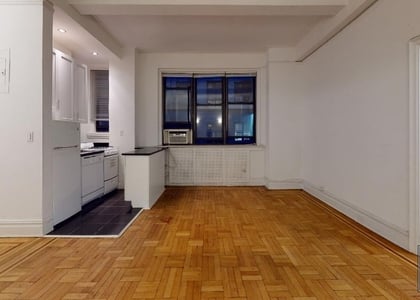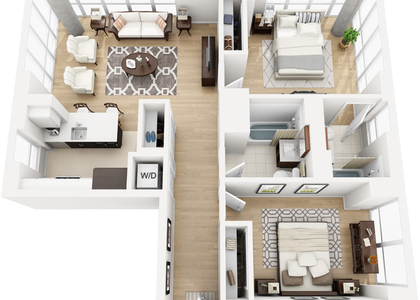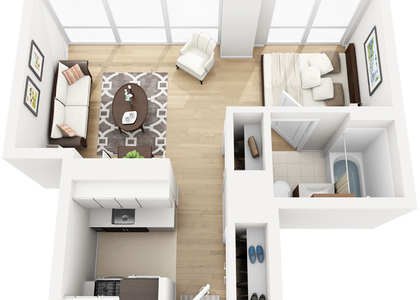Upper Manhattan Apartments for Rent
The general rule for this area is that the further north you go, the more family oriented the neighborhoods become. The northernmost neighborhoods of Upper Manhattan, Inwood and Washington Heights, even have a more Suburban feel, with wider streets and more families.
Upper Manhattan moves at a calmer pace than the rest of the city, focusing more on recreation than the hustle and bustle of big business. With Central Park, Lincoln Center, and all of Harlem, there’s a big focus on art, education, and relaxation. The culinary scene up here is top-notch as well, featuring restaurants run by celebrity chefs and hole-in-the-wall joints with surprisingly delicious gems just waiting to be discovered.
Central Park splits Upper Manhattan right down the middle, which is why subway lines are split between east and west. The Q, 4, 5, and 6 trains take you up the east side while the 1, 2, 3, A, C, B, and D trains take you up the west side.
To get from the west side to the east side, you’ll either need to take a bus or walk/bike across Central Park. The park and the wider uptown roads make this one of the most bike friendly parts of Manhattan. Citi Bike docking stations can be found every few blocks.
The wider roads and proximity to the West Side Highway and FDR also make this a very car friendly area. Just be aware of the alternate side parking rules so you can avoid getting a ticket.
The whole of Upper Manhattan is extremely safe, with the Upper East and Upper West Sides being the safest neighborhoods in Manhattan. Violent crime is extremely rare, as this area is mostly made up of families, socialites, and students. Easy to navigate with a bustling nightlife, residents and tourists alike can feel safe and secure walking these streets.
Mount Sinai and New York Presbyterian’s flagship hospitals are located in this area. With some of the top doctors in the world working in the dozens of healthcare facilities found here, there’s no better place in Manhattan to have a medical emergency.
- Upper West Side: Home to Lincoln Center and the Museum of Natural History.
- Upper East Side: Home to “Museum Mile” featuring the Metropolitan Museum of Art and The Guggenheim.
- East Harlem: Also known as “El Barrio” to the locals, this is a vibrant community full of art and culture.
- Harlem: Home to the Apollo Theater and Red Rooster, owned by celebrity chef Marcus Samuelsson.
- Morningside Heights: Home to Columbia University and Barnard University.
- Hamilton Heights: Home to City College of New York and The Harlem School of the Arts.
- Washington Heights: A family oriented neighborhood and home to New York Presbyterian Hospital.
- Inwood: The northernmost neighborhood in Manhattan and home to The Cloisters.
- Head to Central Park to see Shakespeare in the Park, the Central Park Zoo, or to just gather with friends in the sun.
- Want to see some stellar performance art? Check out Lincoln Center for the Metropolitan Opera, The New York Philharmonic, or a Broadway show at the Vivian Beaumont.
- Interested in art? Check out The Metropolitan Museum of Art or the Guggenheim.
- Hungry for world class dining? Check out Red Rooster from celebrity chef Marcus Samuelsson or Abyssinia Ethiopian Restaurant from chef Frehiwot Reta
- If you’re feeling adventurous, check out Fort Tryon Park and The Cloisters for a relaxing afternoon.
In the early days, Upper Manhattan was used as land for stately manors and farmland. One house, The Morris-Jumel Mansion (The oldest house in Manhattan) still survives from this era. The house was used as a strategic scouting point for the Americans and the British during the revolution.
Throughout the 1800’s Upper Manhattan remained largely empty save a few large houses and farms. However, the city continued to develop further north, and row houses and apartment complexes were built as transit lines crept up north in the 1880’s. Central Park was completed and opened in 1876 and a construction boom in Washington Heights, ending before WW I, attracted many new residents to the area.
The 1900’s were a time of turmoil for Upper Manhattan, with racial discrimination, high crime rates, and political corruption. Starting in the 1990’s, these scars began to heal, and Upper Manhattan transformed into one of the safest places in the entire city. Art, culture, and history are deeply respected and celebrated here to this day.
For those interested, Upper Manhattan currently has
3,497 residential listings advertised on the market for rent.
Listings for rent in this area typically have an median of 750 square feet.
From data that we've compiled, listings range from $3,250 in the lower quartile to $5,500 in the upper quartile.
Generally speaking, the median rental price is around $4,000 or $6.95 / sqft.
For those interested in renting a listing in Upper Manhattan, there are currently 822 studio, 1,220 one-bedroom, 836 two-bedroom, 398 three-bedroom, and 221 four+ bedroom apartments available for rent.
For your convenience, we've included a more detailed breakdown of rental pricing by median bedroom sizes here:
| Bedrooms | Rent | Rent / sqft |
|
|
| Studio |
$3,250
|
$8.07
|
| 1 BR |
$4,289
|
$6.75
|
| 2 BR |
$4,684
|
$6.44
|
| 3 BR |
$6,223
|
$6.84
|
| 4+ BR |
$8,995
|
$7.08
|
We make sure to refresh our rental listings every hour in order to provide you with the newest and most up-to-date inventory available on the market.
Upper Manhattan is located within New York County, New York.
This area currently has 1,634,989 residents in
753,385 households.
Out of the total population, 40.12% of the residents speak another language at home instead of English.
The majority of the inhabitants in this county are currently unmarried and have a median age of 37.
When looking at residents older than 25, around 12.55% have graduated from high school, 31.80% have a bachelor's degree, and 28.64% have obtained their master's degree or above.
Employment rate is typically around 62.9% and the median income in this county is $75,513.
At least 76.86% of those living in this county are renting their homes.
Most residents will commute to work by public transportation with an average commute time of 31 minutes.
Geographically, New York County, New York is a part of the New York - Newark, NY - NJ - CT Urban Area. This county is currently home to 18,812,161 residents, or 6,707,347 households with a median income of $68,319. the New York - Newark, NY - NJ - CT Urban Area residents have a median age of 38 and 50.07% are currently renting their homes in the area.

























